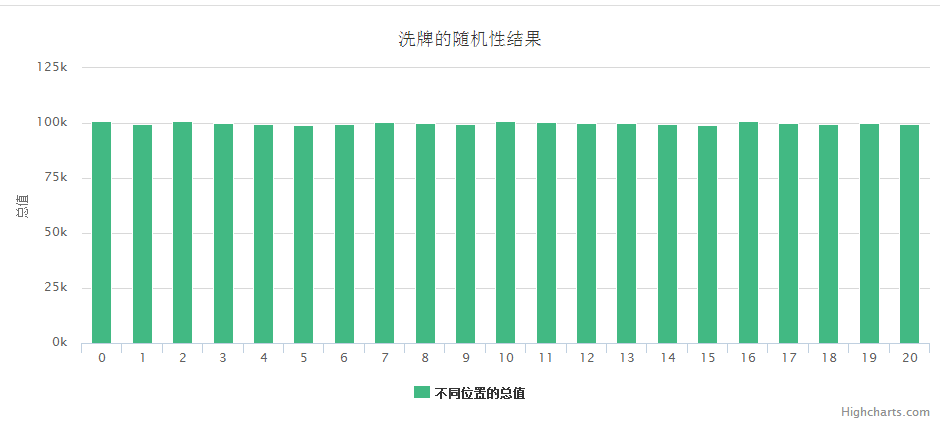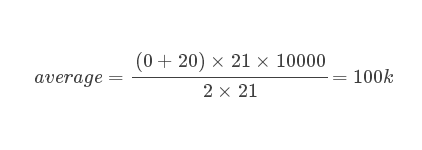
Recommended reading: JavaScript study notes: Adding, deleting, modifying and checking arrays
JavaScript Study Notes Array Sum Method
JavaScript Study Notes Array Random Sorting
Shuffling algorithm is a relatively vivid term, which essentially allows the elements in an array to be arranged randomly. For example, we have an array as shown in the figure below. The length of the array is 9, and the values of the elements in the array are 1~9:

Starting from the above array, what we have to do is to disrupt the order of the elements in the array:

Code implementation
The Fisher–Yates shuffle entry on Wikipedia provides a detailed introduction to the shuffling algorithm. The algorithm demonstrated below is also written based on the theory:
Array.prototype.shuffle = function() {
var input = this;
for (var i = input.length-1; i >=0; i--) {
var randomIndex = Math.floor(Math.random()*(i+1));
var itemAtIndex = input[randomIndex];
input[randomIndex] = input[i];
input[i] = itemAtIndex;
}
return input;
}
var tempArray = [ 1, 2, 3, 4, 5, 6, 7, 8, 9, 10 ]
tempArray.shuffle();
// and the result is...
alert(tempArray); In the above code, we created a shffle() method, which is used to randomly arrange the elements within the array. In addition, we mounted this method under the prototype of the Array object, so any array can call this method directly:
var tempArray = [ 1, 2, 3, 4, 5, 6, 7, 8, 9, 10 ] tempArray.shuffle();
How it works
After reading the code, let’s see what it does to the array. First, this method selects the last element of the array:

Next, determine the range for selecting random elements. From the first element of the array to the element selected in the previous step, they all belong to this range:

After determining the range, randomly select a number from it, assuming that the randomly selected element is 4:

Then swap the values of the last element and the randomly selected element:

After the above exchange is completed, it is equivalent to us completing the random processing of the last element of the array. Next select the second to last element in the array:

The reason why we process it from back to front is that it is easier to determine the range of random selection. This time we assume that the randomly obtained element is 2:

Then exchange the values of the penultimate element and the 2nd element to complete the random arrangement of the penultimate element. Then select the third to last element and repeat the previous operation:

The rest is some repetitive work, so I won’t introduce it much.
Analyzing code
In the previous section, I used an illustration to demonstrate the shuffling process. Now let’s take a look at the shuffling process from the code itself. Let’s start with the shuffle function:
Array.prototype.shuffle = function() {
var input = this;
for (var i = input.length-1; i >=0; i--) {
var randomIndex = Math.floor(Math.random()*(i+1));
var itemAtIndex = input[randomIndex];
input[randomIndex] = input[i];
input[i] = itemAtIndex;
}
return input;
} The shuffle function is mounted under the prototype of the Array object, making it easy for the array to call the function directly. Inside the shuffle function, this refers to the array in which the shuffle is called:
var input = this;
In the above code, I reference this with a new variable, which is the array that the shuffle function is called on. Next, let’s take a look at what’s done inside the for loop:
for (var i = input.length-1; i >=0; i--) {
var randomIndex = Math.floor(Math.random()*(i+1));
var itemAtIndex = input[randomIndex];
input[randomIndex] = input[i];
input[i] = itemAtIndex;
}This loop is used to iterate through all elements in all arrays and perform random exchanges. Note that the traversal order is from back to front, that is to say, start from the element at position input.length-1 until you traverse to the first element in the array. The position during the traversal is specified by the variable i.
The variable i here is the selected element in the legend above:
Shuffling algorithm
Next, two lines of code are used to pick a random element in the specified range:
var randomIndex = Math.floor(Math.random()*(i+1)); var itemAtIndex = input[randomIndex];
变量 randomIndex 存储了一个随机数,该随机数可以用作数组的索引,进而提取一个随机元素。注意,该随机数的最大值并不是数组的长度,而是变量 i 的值。
确定了随机元素的索引之后,用新的变量保存该元素的值,然后交换选中元素和随机元素的值:
var itemAtIndex = input[randomIndex]; input[randomIndex] = input[i]; input[i] = itemAtIndex;
在这三行代码中,第一行使用新的变量保存了随机元素的值;第二行将选中元素 input[i] 的值赋给随机元素 input[randomIndex];第三行就随机元素的值 itemAtIndex 赋给选中元素 input[i]。本质上是一个互换两个元素的值的过程,并不难理解。
至此,循环内的逻辑就介绍完了,剩下的都是重复操作。
随机性测试

上图是使用 Highcharts 制作的随机性测试图表,以可视化的方式校验本文中洗牌算法的随机性。每次刷新页面都会重新计算和生成该图表。
生成上图的数据是这样计算而来的:首先创建一个数组(上图使用的数组为 [0, 1, 2 ... 18, 19, 20]),然后使用本文中的洗牌算法重新排序,排序完成后记录每一个元素的值……以此步骤执行 100000 次,最后对同一索引位置上的数值进行求和。如此执行 10000 次之后,索引之间的总值应该相差不大。
由计算可得:

以上内容是小编给大家介绍的JS随机洗牌算法之给数组随机排序的相关叙述,希望对大家有所帮助!




